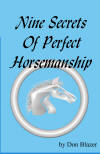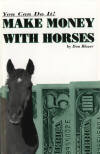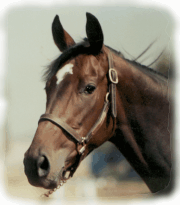
Don Blazer
Archives:
Stop Coggins Slaughter!
Flying Horses?
Don't eat like a Pig
Parasites
Back Sore?
Goat Hero
Communication
Foals
History of Horses
Jumping Horses
Lameness and Health
Kick the IRS
Meet Don Blazer
Books by Don Blazer
View Our Catalog
Secure Book Order Form
Order using our Secure Order Form

Walter (A Horse, of Course) Spills the Oats
Nine Secrets of Perfect Horsemanship
This is a Secure Web Site
|
Maybe itís my imagination--it probably is--but it seems to me there
are more horses with stifle problems today than yesterday.
I suspect it is no great mystery. I suspect it is simply that the
horse industry is growing, and we know more about stifle problems, and we are
using our horses in a different manner.
A stifled horse has always been pretty common at race tracks.
Today, it
seems to me, a stifled horse is also pretty common around show horse barns
and is seen now and then among backyard horses.
A stifled horse is one which has a hind leg "locked" in a fully
extended
position. All the joints of the leg, except the fetlock, are incapable of
movement.
The first time you see a stifled horse you think his leg is broken
and
youíll have to shoot him. Donít!
While the problem can be serious, it very frequently is not.
The most common causes are stress to immature joints, tearing of
ligaments, and faulty conformation--excessively straight hind legs.
The horseís stifle is a hinge joint which corresponds to the human
knee.
As the human knee, it too has a knee cap; the patella.
The stifle joint connects the lower end of the femur and the upper
end of
the tibia. Across this joint rides the patella which is held in place by
three ligaments--one on each side, one in the middle.
Stifling occurs when the medial ligament (the one on the inside of
the
leg) is stretched or loses its "tone" and can no longer hold the patella in
place. The whole joint becomes stuck because the knee cap can no longer
slide over the joint properly.
To relieve a stifled horse, you can back him a few steps slowly, or
you
can extend the leg behind him as far as possible, then carefully move it
forward. Usually the knee cap will pop back into place. Sometimes rocking
the stifle joint from side to side will allow the knee cap to slip back
into place.
A horse which is stifled will often as not unstifle himself. In
many
cases the horse owner does not know for sometime that the horse has a
problem.
But when it is discovered, it is a good idea to keep an eye on the
horse.
With some time, some moderate exercise and some liniment massage, the horse
may be perfectly okay.
Many horses which stifle do so after having been "fit" and worked
hard for
a long period of time, then given a long period of time off. The ligaments
are simply not ready to go back to work, and are lazy about their job. If
the horse is slowly brought back into condition, the problem usually
disappears.
However, if the problem persists, veterinary help may be needed.
The
longer the problem remains uncorrected the more danger of serious
complications.
Relatively simple surgery, which is successful in about 80 per cent
of the
cases, will usually have the horse back at normal work within 60 days.
A local anesthetic is used, and an incision about three-eights of an
inch
long is made. A special knife is inserted, the medial ligament is cut near
the tibia, and the incision is closed. The horse is given 30 days of rest,
followed by several weeks of free exercise, and is then normally put back
into regular work.
More stifle problems are seen at the race track because there are so
many
young horses being trained in one area.
Iím guessing, but I believe there are more stifle problems among
show
horses and horses being used in team events--penning, roping,
sorting--today because more and more riders and trainers are understanding
the necessity for supple horses capable of lateral work.
Lateral work increases a horseís ability to perform smoothly and
quickly.
But lateral exercises need to be practiced in small increments and over a
period of time. The more supple a horse, (the better his lateral work) the
greater his chances of performing at high levels of excellence.
Great performances are built on solid foundations.
Push a horse into lateral work too soon and too hard, and "pop" goes
the
stifle.
Each month you'll find a new column on our web site. We hope you'll enjoy it, and maybe
e-mail us with questions or suggestions for other
columns. A Horse, Of Course is a weekly column syndicated
by Success Is Easy. If you like the column, call your local newspaper, or local horse
publication and ask them to subscribe by contacting Success Is Easy, 13610 N. Scottsdale Rd., Suite 10-406, Scottsdale, AZ 85254
________________________________
A Horse Of Course |
Horse Books Catalog |
Meet Don Blazer
Ask Don Blazer |
Courses and Clinics |
Horse Training
Horses for Sale |
Who's Walter? |
Horse Links
Home
Info@donblazer.com
Copyright © 2000 by
Don Blazer
Success Is Easy, 13610 N. Scottsdale Rd., Suite 10-406, Scottsdale, AZ 85254
Vanndal Web Designs


